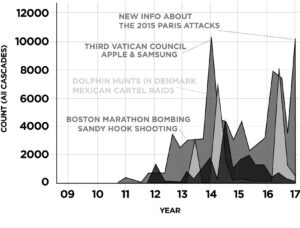This study, which was published on the cover of Science in March 2018, revealed some of the first large-scale evidence on how fake news spreads online. During our research, we discovered what I still, to this day, consider some of the scariest scientific results I have ever encountered. We found that false news diffused significantly farther, faster, deeper, and more broadly than the truth in all categories of information—in some cases, by an order of magnitude. Whoever said “a lie travels halfway around the world while the truth is putting on its shoes” was right. We had uncovered a reality-distortion machine in the pipes of social media platforms, through which falsehood traveled like lightning, while the truth dripped along like molasses.
Figure 1.1 The fact-checked true (light gray), false (dark gray), and mixed (partially true, partially false) (black) news cascades on Twitter from 2009 to 2017. A fact-checked news cascade is a story that was fact-checked by one of six independent fact-checking organizations in our study, diffusing through the Twitter network as it is tweeted and retweeted by Twitter users.
But buried in these more sensational results was a less obvious result, one that is directly relevant to Crimea. As part of our analysis, before building more sophisticated models of the spread of true and false news on Twitter, we produced a simpler graph. We plotted the numbers of true and false news cascades (unbroken chains of person-to-person retweets of a story) in different categories (like politics, business, terrorism, and war) over time (Figure 1.1). The total spread of false rumors had risen over time and peaked at the end of 2013, in 2015, and again at the end of 2016, corresponding to the last U.S. presidential election. The data showed clear increases in the total number of false political rumors during the 2012 and 2016 U.S. presidential elections, confirming the political relevance of the spread of false news.
Figure 1.2 The fact-checked true (light gray), false (dark gray), and mixed (partially true, partially false) (black) political news cascades on Twitter from 2009 to 2017.
But another, more subtle result also drew our attention. Over the ten-year period from 2006 to 2017, there was only one visible spike in the number of rumors that contained both partially true and partially false information, which we called “mixed” rumors. In the original graph, opposite, it was difficult to see. So we filtered the data and replotted the graph, this time considering only political news. That’s when we saw it—a single, clear spike in the spread of stories that contained partially true and partially false information in the two months between February and March 2014 (See the spike labeled “Annexation of Crimea” in Figure 1.2.) It corresponded directly to the Russian annexation of Crimea. This result was striking, not just because it was the largest spike of mixed news in the history of verified stories spreading on Twitter (and more than four times larger than any other spike in mixed political news), but also because it ended almost as quickly as it began, right after the annexation was complete. When we investigated further, we discovered a systematic appropriation of social media by pro-Russian entities that proactively used the Hype Machine to control the Ukrainian national perception of the events in Crimea, and the international perception of what was happening there, to ultimately frame the will of the Crimean people.
A follow up on the previous post. In here, Aral asserts that there was indeed Russian tampering of social media in order to frame the perception of Crimea in its favour.
We are seeing more and more misinformation and alternative news coming in these days, shared not just through social media but even through direct messaging channels like whatsapp. The origins of all these messages remain unclear. But trust in traditional news outlets has been gradually eroding over time, with reason or not. And this will be the new way foreign entities can interfere with local politics for various interests.




